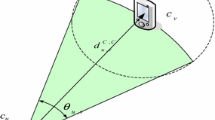Abstract
In the paper, an efficient cooperative neighbor discovery framework for cognitive radio ad-hoc networks (CRAHNs) is proposed for future internet of things. Unlike classical ad-hoc networks, users in a CRAHN do not have a pre-allocated set of channels or common control channel (CCC), which makes the situation much more complicated in neighbor discovery. The proposed framework addresses these issues in the absence of a central controller and a CCC, and can discover a large number of neighbors within a limited time. The absence of a CCC necessitates channel hopping to search for new neighbors, which can be time-consuming with a large number of available channels. In the proposed scheme, a node expedites the rate of neighbor discovery by choosing only a subset of available channels for hopping and working in a group. In addition, while working in a group, the nodes are assigned disjoint sets of channels so that different nodes explore different channels at the same time to discover new neighbors. Simulation results show that the proposed scheme outperforms the random channel hopping scheme which takes whole available channel set to search for neighbors.











Similar content being viewed by others
References
Mitola, J. (2000). Cognitive radio—An integrated agent architecture for software defined radio. Royal Institute of Technology (KTH).
Federal Communications Commission. (2002). FCC spectrum policy task force report, ET Docket, No. 02-135.
Yoon, M., Kim, Y.-K., & Chang, J.-W. (2013). An energy-efficient routing protocol using message success rate in wireless sensor networks. Journal of Convergence, 4(1), 15–22.
Feese, S., Burscher, M. J., Jonas, K., & Trster, G. (2014). Sensing spatial and temporal coordination in teams using the smartphone. Human-Centric Computing and Information Sciences, 4(1), 1–18.
Khan, R. T., Islam, M. I., & Amin, M. R. (2014). Traffic analysis of a cognitive radio network based on the concept of medium access probability. Journal of Information Processing Systems, 10(4), 602–617.
Oh, J.-S., Park, C.-U., & Lee, S.-B. (2014). NFC-based mobile payment service adoption and diffusion. Journal of Convergence, 5(2), 8–14.
Hwang, K., & Nam, S. (2014). Near real-time M2M communication for bidirectional AMR systems. Journal of Convergence, 5(2), 1–7.
Singh, R., Singh, P., & Duhan, M. (2014). An effective implementation of security based algorithmic approach in mobile adhoc networks. Human-Centric Computing and Information Sciences, 4(1), 1–14. doi:10.1186/s13673-014-0007-9.
Singh, R., Singh, P., & Duhan, M. (2014). An effective implementation of security based algorithmic approach in mobile adhoc networks. Human-Centric Computing and Information Sciences, 4(1), 1–14.
Jeong, J.-S., & Bang, D.-W. (2014). An unified representation of context knowledge base for mobile context-aware system. Journal of Information Processing Systems, 10(4), 581–588.
Akyildiz, I. F., Lee, W.-Y., & Chowdhury, K. R. (2009). CRAHNs: Cognitive radio ad hoc networks. Ad Hoc Networks, 7(5), 810–836. doi:10.1016/j.adhoc.2009.01.001.
Gaieniec, L., Pagourtzis, A., & Potapov, I. (2002). Deterministic communication in radio networks with large labels. Algorithmica, 47(1), 97–117. doi:10.1007/s00453-006-1212-3.
Kowalski, D. R., & Pelc, A. (2002). Deterministic broadcasting time in radio networks of unknown topology. In Proceedings of the 43rd annual IEEE symposium on foundations of computer science (pp. 63–72). doi:10.1109/SFCS.2002.1181883.
Hamida, E. B., Chelius, G., & Fleury, E. (2006). Revisiting neighbor discovery with interferences consideration. In Proceedings of the 3rd ACM international workshop on performance evaluation of wireless ad hoc, sensor and ubiquitous networks (pp. 74–81). doi:10.1145/1163610.1163623.
Vasudevan, S., Towsley, D., Goeckel, D., & Khalili, R. (2009). Neighbor discovery in wireless networks and the coupon collectors problem. In Proceedings of the 15th annual international conference on mobile computing and networking (pp. 181–192). doi:10.1145/1614320.1614341.
Kowalski, D. R., & Pelc, A. (2005). Broadcasting in undirected ad hoc radio networks. Distributed Computing, 18(1), 43–57. doi:10.1007/s00446-005-0126-7.
Czumaj, A., & Rytter, W. (2003). Broadcasting algorithms in radio networks with unknown topology. In Proceedings of 44th annual IEEE symposium on foundations of computer science (pp. 492–501). doi:10.1109/SFCS.2003.1238222.
Chrobak, M., Gasieniec, L., & Rytter, W. (2000). Fast broadcasting and gossiping in radio networks. In Proceedings of 41st annual symposium on foundations of computer science (pp. 575–581). doi:10.1109/SFCS.2000.892325.
Romaszko, S. (2012). Making a blind date the guaranteed rendezvous in cognitive radio ad hoc networks. In Proceedings of 18th European wireless conference (pp. 1–9).
Liu, H., Lin, Z., Chu, X., & Leung, Y.-W. (2010). Ring-walk based channel-hopping algorithms with guaranteed rendezvous for cognitive radio networks. In Proceedings of the 2010 IEEE/ACM international conference on green computing and communications & international conference on cyber, physical and social computing (pp. 755–760). doi:10.1109/GreenCom-CPSCom.2010.30.
Liu, H., Lin, Z., Chu, X., & Leung, Y.-W. (2012). Jump-stay rendezvous algorithm for cognitive radio networks. IEEE Transactions on Parallel and Distributed Systems, 23(10), 1867–1881. doi:10.1109/TPDS.2012.22.
Misic, J., Khojasteh, H., Khan, N., & Misic, V. B. (2012). Towards an efficient rendezvous protocol for a cognitive PAN. In Proceedings of 2012 IEEE international conference on communications (ICC) (pp. 1795–1799). doi:10.1109/ICC.2012.6364445.
Misic, J., & Misic, V. B. (2014). Probabilistic vs. sequence-based rendezvous in channel-hopping cognitive networks. IEEE Transactions on Parallel and Distributed Systems, 25(9), 2418–2427. doi:10.1109/TPDS.2013.192.
Mittal, N., Krishnamurthy, S., Chandrasekaran, R., Venkatesan, S., & Zeng, Y. (2009). On neighbor discovery in cognitive radio networks. Journal of Parallel and Distributed Computing, 69(7), 623–637. doi:10.1016/j.jpdc.2009.03.008.
Zeng, Y., Mittal, N., Venkatesan, S., & Chandrasekaran, R. (2010). Fast neighbor discovery with lightweight termination detection in heterogeneous cognitive radio networks. In Proceedings of 2010 ninth international symposium on parallel and distributed computing (ISPDC) (pp. 149–156). doi:10.1109/ISPDC.2010.32.
Song, Y., & Xie, J. (2012). A distributed broadcast protocol in multi-hop cognitive radio ad hoc networks without a common control channel. In Proceedings of IEEE INFOCOM 2012 (pp. 2273–2281). doi:10.1109/INFCOM.2012.6195614.
Acknowledgments
This research was supported by Basic Science Research Program through the National Research Foundation of Korea (NRF) funded by the Ministry of Education (2013R1A1A2063779).
Author information
Authors and Affiliations
Corresponding author
Rights and permissions
About this article
Cite this article
Mahmud, A., Lee, YD. & Koo, IS. An Efficient Cooperative Neighbor Discovery Framework of Cognitive Radio Ad-Hoc Networks for Future Internet of Things. Wireless Pers Commun 91, 1603–1620 (2016). https://doi.org/10.1007/s11277-015-3143-2
Published:
Issue Date:
DOI: https://doi.org/10.1007/s11277-015-3143-2




